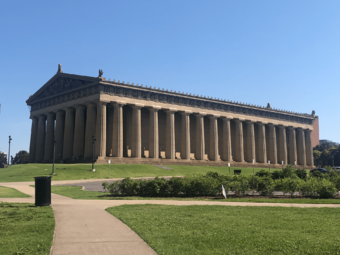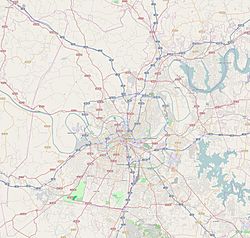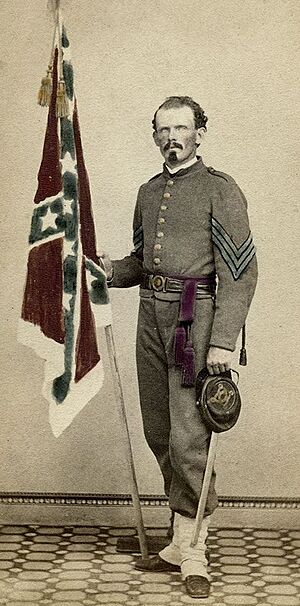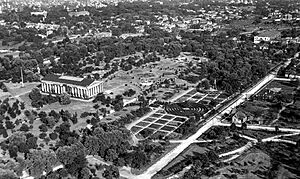Parthenon (Nashville) facts for kids
Quick facts for kids |
|
|
The Parthenon
|
|

The Parthenon in Nashville's Centennial Park is a full-scale copy of the original Parthenon in Athens.
|
|
| Location | Nashville, Tennessee, United States |
|---|---|
| Built | 1897 (original structure) 1925–1931 (permanent version) |
| Architect | William Crawford Smith |
| Architectural style | Classical |
| NRHP reference No. | 72001236 |
| Added to NRHP | February 23, 1972 |
The Parthenon in Nashville, Tennessee, is a full-size copy of the famous ancient Greek temple in Athens, Greece. It stands in Centennial Park. An architect named William Crawford Smith designed it. It was first built in 1897 for a big event called the Tennessee Centennial Exposition.
Today, this Parthenon is an art museum. It is the main attraction in Centennial Park, which is a public park in Nashville. Inside, you can see a huge statue of Athena Parthenos. This statue was made in 1990 by Alan LeQuire. It looks just like the original statue that was in the ancient Greek Parthenon.
This Nashville Parthenon is a great example of classical architecture. Its decorations were painted in colors, just like the original temple. It helps us imagine what the ancient Parthenon looked like long ago. In one room, there are plaster copies of the Parthenon Marbles. These are sculptures that decorated the original Parthenon in Athens around 438 BC.
Contents
Why Nashville Has a Parthenon
Nashville is often called the "Athens of the South." This nickname helped inspire the idea to build a Parthenon for the 1897 Centennial Exposition. Many buildings at this event looked like ancient structures. But the Parthenon was the only one that was an exact copy.
The city decided to keep the Parthenon after the Exposition ended. It was very popular with both locals and visitors. It also would have cost a lot to tear it down. So, it stayed!
Building the Parthenon
Major Eugene Castner Lewis was in charge of the Tennessee Centennial Exposition. He suggested building a Parthenon copy as the main feature. The first Parthenon was made from plaster, wood, and brick. It was not meant to last forever.
Over the next 20 years, weather started to damage the building. So, a project began in 1920 to rebuild it. This time, it was made from strong concrete. The outside was finished in 1925, and the inside was done in 1931. Local architect Russell Hart helped with this rebuilding.
Early Events at the Parthenon
In 1913 and 1914, big theatrical shows called Spring Pageants took place at the Parthenon. These shows had up to 500 performers. They attracted many people from nearby states. Train ticket prices were even lowered to help people attend.
The 1913 show was called The Fire Regained. It was a play by Sidney Mttron Hirsch. It told a mythological story with lots of special effects. The 1914 show, The Mystery at Thanatos, also had a mythological plot. Both shows featured exciting displays. These included chariot races, large dance numbers, and even thousands of live birds.
What You Can See Today
The Parthenon is an art museum. On the lower level, you can see 63 paintings. These are by American artists from the 1800s and 1900s. James M. Cowan donated them between 1927 and 1929. Other rooms host temporary art shows and exhibits.
The Giant Athena Statue
The main level features the amazing replica of the Athena Parthenos statue. It was finished in 1990 by Alan LeQuire. This statue is a careful reconstruction of the original, which was lost long ago.
Athena wears armor and a helmet. She holds a shield on her left arm. In her right hand, she holds a 6-foot-tall statue of Nike, the goddess of Victory. The Athena statue itself is 42 feet (13 meters) tall! It was covered with more than 8 pounds (3.6 kg) of gold leaf in 2002. A huge snake rises between her and her shield.
Plays and Performances
In the summer, local theater groups use the Parthenon as a backdrop. They perform classic Greek plays like Medea and Antigone. These shows are often free and take place on the Parthenon's steps. Other plays, like Mary Zimmerman's Metamorphoses, have been performed inside.
In 2001, the Parthenon's outside was cleaned and restored. The outdoor lights were also updated. Now, the columns can be lit up in different colors.
Images for kids
See also
 In Spanish: Partenón (Nashville) para niños
In Spanish: Partenón (Nashville) para niños












